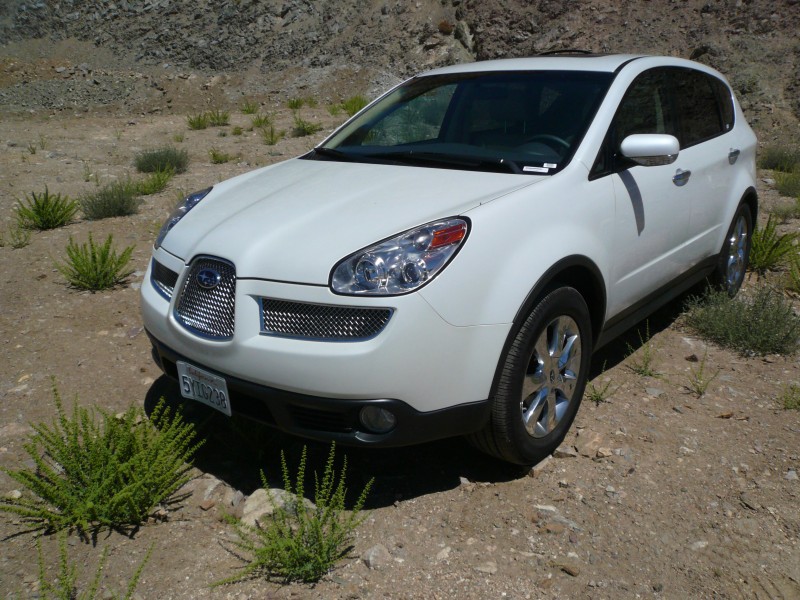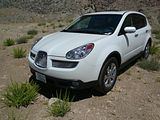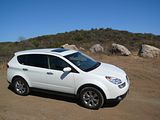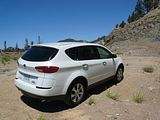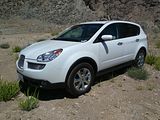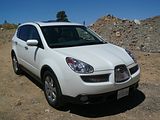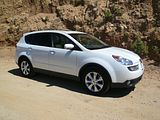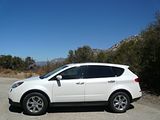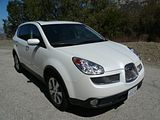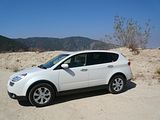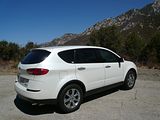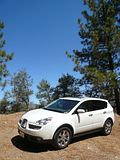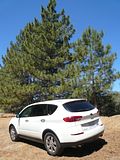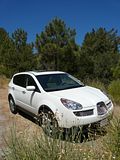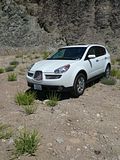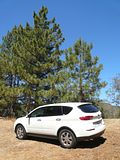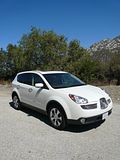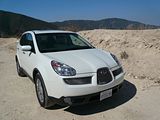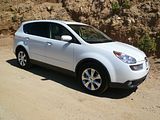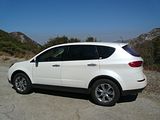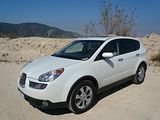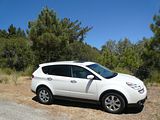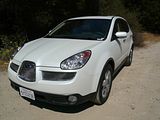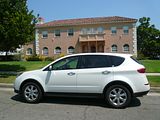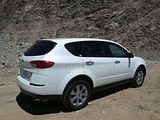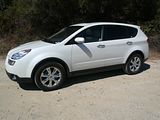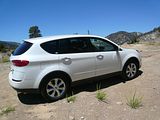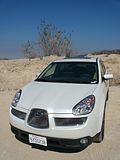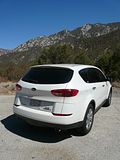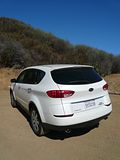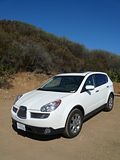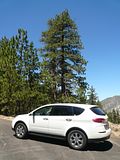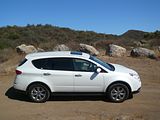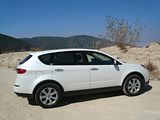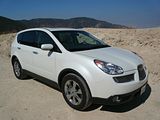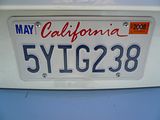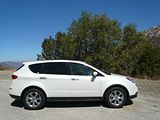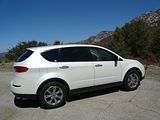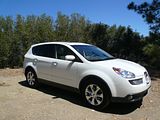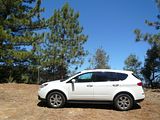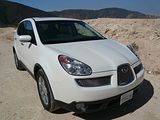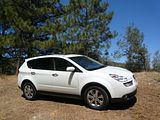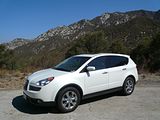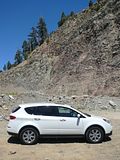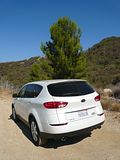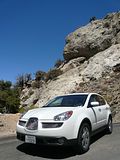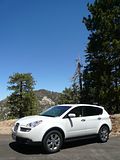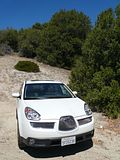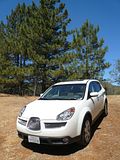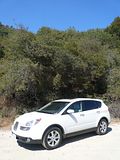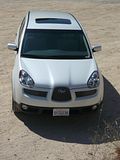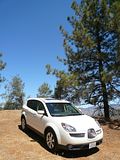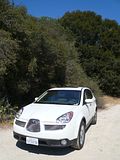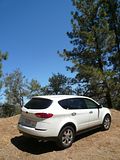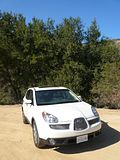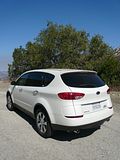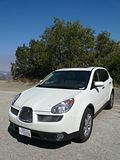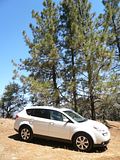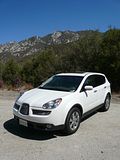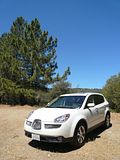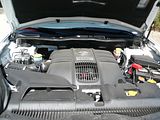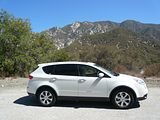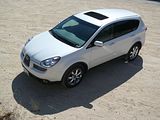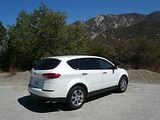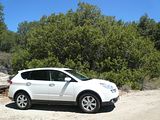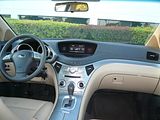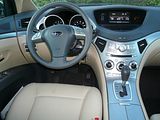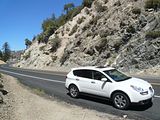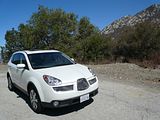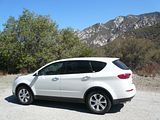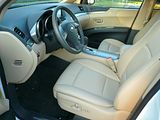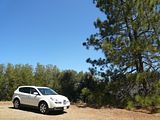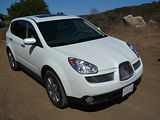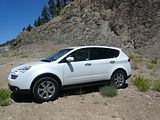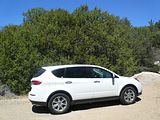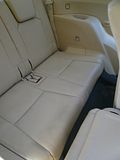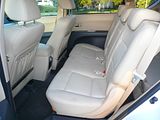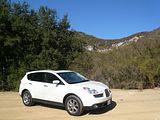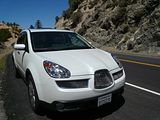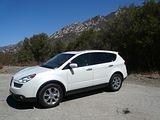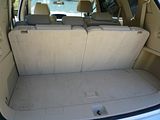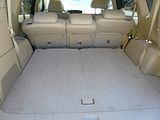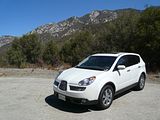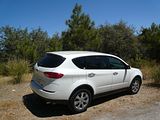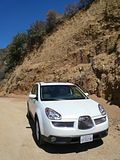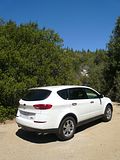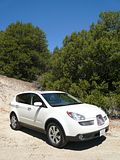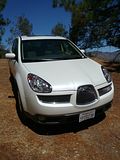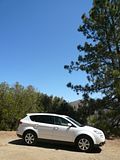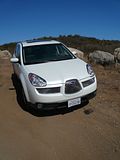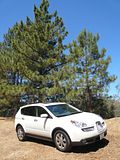Although a stream of text articles, speculative artist impressions and photos of development cars with varying degrees of camouflage mean that by the time of an actual launch, not only is the existence of a new model not a surprise, but we all generally know exactly what it looks like. That does not stop the world’s car manufacturers from staging dramatic launches, attended generally by the motoring press, where either a cover is dramatically whipped off, or lights are suddenly turned on. The correct and expected reaction is a combination of gasps of surprise and delight and lots of applause. I was not at the launch on press day at the 2005 North American International Auto Show in Detroit of the latest test car, Subaru’s B9 Tribeca, but l know someone who was. He reported that when the covers did come off, there was just a stunned silence, and then after a long pause, there was some awkward clapping, though he heard the word “Edsel” muttered by more than one person present. Not exactly the response that its proud creator was hoping for, I am sure. And when the rest of the world saw the images of Subaru’s first attempt at a mid-sized Crossover, bigger than the Forester and aimed at taking on cars like the Nissan Murano and Toyota Highlander, we could all see why there had not been an enthusiastic reception, as the car certainly won’t – by the standards of just about everyone – win prizes for its beauty.
You can certainly see the rationale for the B9 Tribeca. Subaru has made a name for itself with a standard all-wheel drive system on all its cars, which either means traction and grip for those who live in the snow belt States, where their cars sell strongly, or for performance reasons with the successful rally cars that dominated the forests a few years ago. Combine this with the growing popularity in the market, especially in America, for Sport Utility or Crossover-type vehicles, most of which come with an all-wheel drive option and it would be safe to conclude that Subaru should be well positioned to do well in his segment with a product which could leverage their reputation and giving loyal brand supporters something to migrate to from the conventional Legacy saloon and Outback and Forester estate bodies to cars of this type, as well as making conquest sales. Models such as Toyota’s Highlander and the Lexus RX had already proved that there is a market for such cars and recent additions to the segment such as Ford’s Edge and the Nissan Murano have further shown that you can include a dose of style and make the cars almost as good to drive as the saloons whose components they share. I am sure that Subaru’s product planners were aiming to achieving the same sort of thing. Even the name was intended to bolster the image of the car, with the initial proposal of B9, which was going to be the start of a range-wide renaming gaining the word Tribeca, a trendy area of New York to suggest that this was a car for the cities as well as the open spaces.
I arrived in Los Angeles on a Sunday afternoon, having spent a few days working in the Chicago area driving around the quintessence of old-school American motoring, a Lincoln Town Car, so was keen to drive something quite different. There were plenty of cars on site at Hertz’ Los Angeles facility, so picking was actually quite hard, but one of the rental car staff decided she would help me and took me on a tour of the parking lot pointing out a few cars which other customers had rated and also a few which are rare spots. My eye was caught by a nearly new B9 Tribeca as something I’d not seen there before and this particular and helpful agent was happy to make it available to me. I had a few days with a mix of work and evening free time to see what I though of Subaru’s latest creation.
Powering every version of the Tribeca is a 3.0 litre flat six engine. It develops 245 bhp and 210 lb/ft of torque and is coupled to a five speed automatic gearbox. Like all Subarus, there is standard permanent all-wheel drive. Performance is best described as leisurely, with an official 0 – 60 mph time of around 9.5 seconds being quoted, which is frankly slow by today’s standards and when you work the car hard, which you will do, it becomes quite noisy and rough. And you will be doing that, as I was, and the result of this is a consequent thirst. After 120 miles, the fuel gauge was showing a low enough level that I had to refill the car, which was not impressive. Once you reach a cruising speed on the freeway, noise levels are quite well controlled, so the car is a peaceful cruiser, but if you get baulked in traffic and need acceleration, you will have to work the car hard to regain momentum and that is not such a good experience. Although Nissan’s Murano proves otherwise, generally cars of this class are not that much fun to drive and the Tribeca certainly does not deviate from that norm. The steering is light and lacks much in the way of feel. The car does not corner particularly tidily, and despite the low-set float six engine there is still plenty of roll in the corners and although there is lots of grip thanks to the all-wheel drive system, there is also plenty of understeer. At least the car rides with a certain pliancy that handles some of the worse road surfaces of the LA area. There were no issues with the brakes. A foot pedal operated parking brake features. Visibility is generally good, with the fairly vertical rear of the car making it easy to judge where the back of the car is, and it was surprisingly manoeuverable for a large car. The Limited trim spec of the test car adds a glass sunroof to the spec.
Subaru has never really been known for the high quality of its interiors, preferring durability (which is generally good) to the use of lots of soft plastics and even a cohesive design. Knowing that the Tribeca would have a much higher price point than the rest of their range, they have tried hard here and they have certainly evidenced progress if not completely succeeded. The design certainly flows well, from the door casings across the entire dash which also swoops down in the middle to continue as a high set centre console. The test car had a dashboard whose upper surface was a dark brown and the lower surface a light oatmeal colour which matches the seat upholstery, with a gunmetal coloured inlay that lines the centre console and surrounds the instrument cluster. There is a leather wrapped steering wheel. The speedometer and rev counter sit in their own individual deeply recessed cowls in the instrument cluster, with smaller fuel level and water temperature gauges set outside these. They are clearly marked and easy to read. Twin column stalks take care of the indicators, wipers and lights and there is an additional stubby stalk to the lower right side of the wheel for cruise control. There are buttons on the steering wheel boss for audio repeater functions. The centre of the dash contains an integrated multi-function display unit which shows the audio selections along with trip computer functions and some of the in-car warnings. Beneath this, between the central air vents are a series of flush fitting buttons for the audio unit and the CD slot and then beneath these are rotary dials and buttons for the dual-zone climate control.
The Limited trim spec of the test car means leather upholstery, and there is electric adjustment for the front seats, with buttons on the side of the seat to allow you to move it back and forth as well as up and down and to alter the backrest rake. There are two memory settings to store your preferred positions. Couple this with a wide range of adjustment for the steering column and it was easy to get the driving position I wanted. You did sit a little higher in the Tribeca than in a conventional estate car, which gives you a better view of what is going on outside, but you are not so high that it is hard to get in our out.
The whole point of a Crossover of this size is to provide lots of room for people and luggage. Sadly, the Tribeca does not score well here. My test car was the 7-seater version, which means that there is a third row which inevitably is only really of any use for children. It is legroom that is in particularly short supply here, as with the front seats set well back, there is very little of it indeed. Even with the seat set well forward, as it is for my desired driving position and space is not particularly generous. Headroom is not a problem and the Tribeca is wide enough that three adults could doubtless fit across the car. Access to the third row is difficult, with the middle seats folding forward but you will still need to be pretty agile to get in here and even more so to get out. The third row seats are set quite low which means that there is not much in the way of a footwell, so occupants here with legs of even modest length will find that their knees are headed towards their chins. Width won’t be the problem for there are only 2 seats here and headroom should also suffice. Occupants here get wells in the side mouldings for cupholders, but there is no other provision for odds and ends.
The problem with almost all 7-seaters, even of this size, is that boot space tends to be marginal when the third row is erect. The Subaru is actually better than most and there was ample room to get my suitcase and laptop bag in, albeit with the case on its end rather than lying flat. The floor is flush with the bottom of the tailgate so although you have to lift things quite high thanks to the tall stance of the car, it is then quite easy to slide things in. There is a small underfloor stowage area around the spare wheel. The third row of seats are split 50/50 and the backrest simply drop down creating a flat and long load bay. The middle row are split three ways, 40/20/40 and once these are all folded down as well, there is a vast space for luggage. Inside the cabin there is a good sized glovebox, pockets on the doors and a deep area in the centre console between the seats.
In the US, the 2007 Subaru B9 Tribeca comes in two trim levels, base and Limited, and buyers can choose five- or seven-passenger versions of either. Standard features on the five-passenger base model include power front seats, dual-zone automatic climate control, keyless entry, a sliding 60/40-split second-row seat and a sunroof. Seven-passenger versions add a 50/50-split folding third-row seat, heated front seats and rear climate controls. Step up to the Limited on both the five- and seven-passenger versions and you’ll get extras such as leather seating, a 160-watt stereo with six-disc CD changer and memory settings for the two front seats as standard equipment. Notable options include a rear-seat DVD entertainment system and a navigation system with rear parking camera. The test car was in Limited trim.
Subaru have tried to sell the Tribeca in Europe, though it is a moot point whether they really expected significant numbers of them to be bought, especially given the lack of a diesel engine option, which is pretty much what all European buyers will want, for fiscal reasons. To date they have found just 194 buyers in the UK, which means that it was probably barely worth all the effort in getting the car approved for sale and must surely rank as a disappointment. But having driven a US spec Tribeca, it’s not that hard to see why. The car seems to fall between every proverbial stool: it is larger than the Forester but does not really score with any extra space except for the presence of the third row of seats; the 3.0 litre engine makes it very thirsty but the car still feels sluggish and so it is not fun to drive and the interior quality, although superficially attractive, is not up to the standards of most of its rivals. Sales in the US have been better, but again far from stellar and this is in a market that buys large numbers of the rest of the Subaru range. So it would seem that the rather muted reaction at the car’s launch was quite prescient not just of its looks but of the car as a whole. What a shame.

